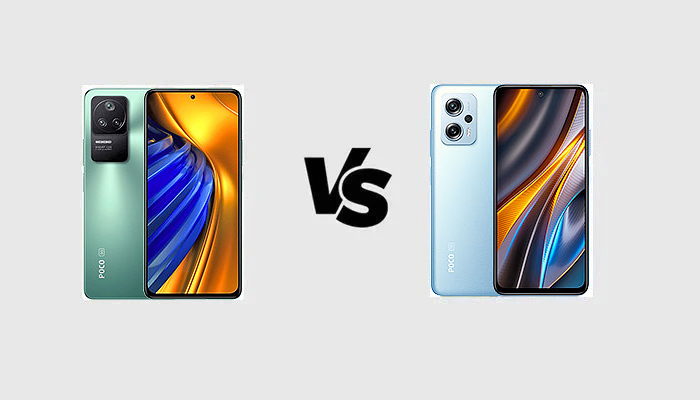After the amazing POCO F4 GT with Snapdragon 8 Gen 1 inside, Xiaomi’s sub-brand launched a brand new duo of phones in the European market: the POCO F4 and the POCO X4 GT. They are two lower-end devices, but they can still be considered good flagship killers for gamers and power users thanks to high-end hardware departments. A lot of expert people will choose them because of their performance and they could become best-sellers due to their affordable prices. But which one is the best and which is the most suitable one for your actual needs? In order to answer this question, we decided to publish a comparison between the specifications of the POCO F4 and the POCO X4 GT.

Xiaomi POCO F4 vs Xiaomi POCO X4 GT
| Xiaomi POCO F4 | Xiaomi POCO X4 GT | |
|---|---|---|
| DIMENSIONS AND WEIGHT | 163.2 x 76 x 7.7 mm, 195 g |
163.6 x 74.3 x 8.9 mm, 200 g |
| DISPLAY | 6.67 inches, 1080 x 2400 pixels (Full HD+), AMOLED | 6.6 inches, 1080 x 2460 pixels (Full HD+), IPS LCD |
| PROCESSOR | Qualcomm Snapdragon 870, octa-core 3.2 GHz | Mediatek Dimensity 8100, octa-core 2.85 GHz |
| MEMORY | 6 GB RAM, 128 GB – 8 GB RAM, 128 GB – 8 GB RAM, 256 GB – 12 GB RAM, 256 GB | 8 GB RAM, 128 GB – 8 GB RAM, 256 GB |
| SOFTWARE | Android 12, MIUI for POCO | Android 12, MIUI for POCO |
| CONNECTIVITY | Wi-Fi 802.11 a/b/g/n/ac/6, Bluetooth 5.2, GPS | Wi-Fi 802.11 a/b/g/n/ac/6, Bluetooth 5.3, GPS |
| CAMERA | Triple 64 + 8 + 2 MP, f/1.8 + f/2.2 + f/2.4 20 MP f/2.5 front camera |
Triple 64 + 8 + 2 MP, f/1.9 + f/2.2 + f/2.4 20 MP f/2.5 front camera |
| BATTERY | 4500 mAh, fast charging 67W | 5080 mAh, Fast Charging 67W |
| ADDITIONAL FEATURES | 5G, dual SIM, IP53 certification | 5G, dual SIM |
Design
Do you prefer having a more ergonomic device? If so, then you should go for the POCO F4 because it has a thinner and lighter design: it weighs 195 grams and is 7.7 mm thick. Further, it offers an important pro: it has the IP53 certification making it dust resistant and splash resistant. You might like the POCO X4 GT because it comes with a cleaner design, thanks to the camera module sporting the same color as the rest of the rear side. But it is thicker and heavier than its internal rival, so less ergonomic. Unfortunately, both these phones are made of polycarbonate and they are not built with premium materials. However, their displays are protected by Gorilla Glass 5, so they should be very resistant to scratches, even though we recommend leaving a screen protector applied to the front glass.
Display
The best display in this comparison belongs to the POCO F4. It is equipped with an amazing AMOLED panel sporting a diagonal of 6.67 inches, a Full HD+ resolution of 1080 x 2400 pixels, a 120 Hz refresh rate, the HDR10+ certification, and Dolby Vision. It provides a great image quality with vibrant colors and deep blacks, and it is amazing even on streaming platforms. It even provides very high brightness with up to 1300 nits and the Gorilla Glass 5 protection. Even though it is an AMOLED panel, the fingerprint reader of the POCO F4 is not in-display but side-mounted, and there are stereo speakers for an improved audio experience. The display of the POCO X4 GT is great for gamers thanks to its 144 Hz refresh rate, but, unfortunately, it is an IPS LCD panel. The image quality is great thanks to the HDR10 certification and Dolby Vision, but it can not compete with AMOLED panels sporting the same specifications. Naturally, even in this case, the fingerprint scanner is side-mounted.
Specs & Software
The most advanced hardware setup belongs to the POCO X4 GT: it is fueled by the Mediatek Dimensity 8100 mobile platform paired with 8 GB of RAM and up to 256 GB of UFS 3.1 internal storage. The Dimensity 8100 chipset built at 5 nm with a max frequency of 2.85 GHz (alongside its Max variant with improved AI performance) is the best Mediatek chipset after the Dimensity 9000 and the Dimensity 9000+, so it provides flagship-class performance. The POCO F4 is inferior because it is powered by the older Snapdragon 870 chipset built at 7 nm and running at a max frequency of 3.2 GHz. In this case, the SoC is paired with up to 12 GB of RAM and up to 256 GB of UFS 3.1 internal storage. Both handsets run Android 12 out of the box, customized by MIUI 13 in a special version for POCO devices.
Camera
There are no differences between the camera departments of these two phones, with the exception of a single element. On the rear side, you can find a 64 MP main camera, an 8 MP ultrawide lens, and a 2 MP macro camera, while frontally, there is a 20 MP selfie shooter. The difference between these two models is the presence of OIS on the POCO F4, which improves the photo quality thanks to better stabilization.
Battery
If you are looking for a phone with the longest battery life, then the POCO X4 GT is the best choice you can do. It is equipped with a 5080 mAh battery and thanks to this battery, even though it has an IPS display, it lasts more on a single charge. Also, note that its processor is more efficient because it is built at 5 nm. The 4500 mAh battery of the POCO F4 is still sufficient, but nothing special if compared to the X4 GT. Both the phones support 67W fast charging, but the F4 charges quicklier because it has a smaller battery.
Price
The starting price of the POCO F4 in the European market is €399/$419, while you need €299/$315 to purchase the X4 GT. The former looks more interesting due to its better display, but the latter comes with a bigger battery and a better processor.
Xiaomi POCO F4 vs Xiaomi POCO X4 GT: PRO and CONS
Xiaomi POCO F4
PRO
- AMOLED display
- IP53 certification
- Thinner and lighter
- Better camera
CONS
- Inferior hardware
Xiaomi POCO X4 GT
PRO
- Superior chipset
- Higher refresh rate
- Bigger battery
- More affordable
CONS
- IPS display
RELATED
- OPPO Find X5 vs Find X5 Pro vs Find X5 Lite: Specs Comparison
- Samsung Galaxy S22 Ultra vs Vivo X Note vs iPhone 13 Pro Max: Specs Comparison
- OPPO Reno7 vs Reno7 Pro vs Reno7 SE: Specs Comparison
- Motorola Edge X30 vs Galaxy S21+ vs Xiaomi 11T Pro: Specs Comparison
Check the latest videos from our YouTube channel and subscribe:






